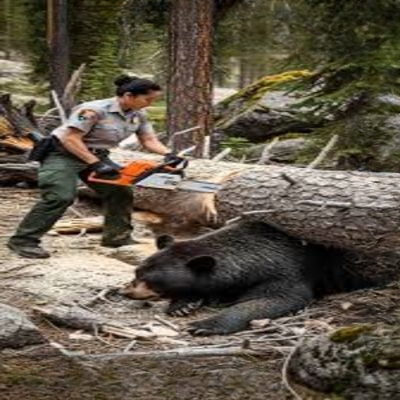Courage in the Pines: The Ranger Who Saved a Trapped Black Bear
Posted onSeptember 23, 2025 ByadminNo Commentson Courage in the Pines: The Ranger Who Saved a Trapped Black Bear
When hikers reported eerie growls echoing through a remote stretch of pine forest, many immediately assumed that a wild predator was nearby. Some feared they had wandered too close to a territorial bear or another large animal, poised to defend its territory.
What they discovered, however, was far more startling—and far more poignant. A massive black bear lay trapped beneath a fallen tree, struggling to survive. What could have ended in tragedy became a breathtaking story of courage, compassion, and the delicate bond between humans and the natural world.
A Scene of Tension and Compassion
Deep within the untamed wilderness, where ancient pines tower over quiet trails and the air hums with the subtle music of unseen wildlife, a remarkable rescue unfolded. Guided not by fear or brute force, but by empathy, skill, and determination, a park ranger confronted a situation that would test both physical and emotional resilience: freeing a black bear pinned under a crushing trunk.
The rescue began when hikers, startled by unsettling growls, called for help. Following the sound, the ranger discovered the bear’s plight: its powerful frame immobilized, trapped under a massive fallen tree. Despite the animal’s natural strength, the weight of the trunk left it helpless. Its shallow, labored breathing and strained movements revealed the gravity of its condition—without immediate intervention, the bear would not survive.
Instead of seeing the animal as a threat, the ranger saw a life in peril. Equipped with a chainsaw, the ranger began the painstaking work of carefully cutting through the trunk. Every movement required precision: a miscalculation or excess vibration could worsen the bear’s injuries, while the roar of the chainsaw risked further distressing it. Yet through steady hands, patience, and unwavering focus, the ranger worked to give the bear a second chance at life.
Understanding Black Bears: Behavior and Habitat
To appreciate the full magnitude of this rescue, it helps to understand the creatures involved. Black bears (Ursus americanus) are among North America’s most widespread large mammals, inhabiting forests, mountains, and swamps across the continent. Despite their reputation as formidable predators, black bears are generally solitary, elusive, and more likely to avoid humans than confront them.
Bears play a crucial role in ecosystems. As omnivores, they help control insect populations, disperse seeds, and maintain forest health. Their presence indicates a balanced, thriving environment. Yet their natural habitats are increasingly threatened by human expansion, road construction, and deforestation. Encounters between humans and bears, while relatively rare, require caution, respect, and awareness of the animal’s behavior.
Black bears are also physically strong and agile. An adult male can weigh between 200 and 600 pounds, while females range from 150 to 400 pounds. Despite their size, even a strong bear is vulnerable when immobilized or trapped. The situation faced by the ranger was extraordinary because the bear’s natural strength could not compensate for the crushing weight of the fallen tree.
The Rescue: Step by Step
Those who witnessed the rescue describe it as tense and unforgettable. The air was thick with anticipation: the low, guttural sound of the bear’s breathing, the relentless buzz of the chainsaw, and the silent focus of the ranger working methodically against time.
Assessment: Before taking action, the ranger evaluated the bear’s position. Ensuring that the bear could not accidentally shift and worsen its injuries was critical. A misjudgment could have been fatal for both the animal and the rescuer.
Stabilization: Using ropes and carefully positioned supports, the ranger stabilized the tree to prevent sudden movement during cutting. This step required an understanding of physics, animal behavior, and improvisational problem-solving under pressure.
Cutting: With a chainsaw in hand, the ranger made precise cuts through the trunk. The roar of the saw was deafening, yet the ranger maintained focus, balancing speed with caution. Each cut had to be deliberate to avoid shaking the trunk excessively or causing splinters that might injure the bear.
Monitoring: Throughout the process, the ranger monitored the bear’s breathing, body position, and stress level. Small cues—a shift of its paw, a flicker of the eyes—indicated whether the bear was too stressed or in pain, requiring pauses to avoid further harm.
Liberation: After what seemed like an eternity, the final cut was made. The massive log rolled free. The bear, exhausted but alive, struggled to stand. Its pause—a silent, fleeting glance at the ranger—was a profound moment of recognition and connection before it disappeared into the forest.
Witnesses described the encounter as surreal. A creature of immense power, once helpless, returned to freedom thanks to human courage, skill, and empathy.
Park Rangers: Guardians of the Wild
This extraordinary incident highlights the vital role of park rangers. Beyond routine duties such as patrolling trails, preventing wildfires, and guiding visitors, rangers serve as the silent guardians of wildlife and ecosystems. Their responsibilities often extend into life-or-death scenarios, where human intervention can determine survival.
Park rangers receive extensive training to handle wildlife emergencies, including:
Animal behavior assessment: Understanding signs of stress, aggression, or vulnerability.
Safe handling techniques: Using equipment like ropes, chainsaws, and immobilization tools without causing harm.
Emergency medical support: Administering first aid to animals in distress.
Coordination with authorities: Engaging wildlife experts or veterinarians when situations exceed personal capacity.
Moments like the bear rescue reflect the deeper purpose of these roles: protecting life in all its forms, even when personal risk is high. The ranger’s actions illustrate that true strength is measured not by dominance over nature, but by empathy, patience, and courage.
The Human-Wildlife Connection
The bear rescue also serves as a reminder of the profound connections possible between humans and the natural world. Across history, humans have revered wildlife as symbols of strength, resilience, and balance. Today, these connections are increasingly tested as urbanization, climate change, and habitat loss encroach on wilderness areas.
Acts of compassion like this rescue highlight that coexistence is possible. By respecting wildlife, intervening when appropriate, and supporting conservation, humans can play a role in maintaining healthy ecosystems. Stories of rescue and care inspire broader awareness about the fragility of nature and our moral responsibility to safeguard it.
Lessons in Empathy and Responsibility
Several lessons emerge from this encounter:
Compassion matters: Even the fiercest animals deserve respect and care when in distress.
Skill and knowledge save lives: Understanding wildlife behavior and rescue protocols allows rangers and concerned citizens to act effectively.
Small actions have ripple effects: By saving a single bear, the ranger contributed to maintaining ecological balance in the forest.
Courage is multifaceted: True bravery involves empathy, patience, and careful risk assessment, not recklessness.
The ranger’s decision to act reflects a broader ethic: humans have a moral responsibility to protect the natural world and the creatures within it.
Community Impact and Public Awareness
News of the bear rescue quickly spread, capturing the attention of local communities and conservation groups. Many praised the ranger’s dedication, highlighting the story as a model for responsible environmental stewardship. Schools, outdoor clubs, and social media audiences shared the story widely, using it as a teaching moment about wildlife safety, conservation, and the value of empathy.
Public response also underscores a societal shift: people increasingly recognize the importance of coexistence with wildlife, rather than domination over it. Encounters like this one remind communities that respecting and protecting animals benefits both nature and humans.
Broader Environmental Context
The story is also a call to action regarding habitat protection. Black bears, while adaptable, are sensitive to habitat fragmentation, human activity, and deforestation. The survival of individual animals is intimately connected to the health of their ecosystems. By rescuing one bear, the ranger indirectly contributed to preserving the broader environmental balance.
Furthermore, stories like this highlight the need for public education on human-wildlife interactions. Simple awareness—keeping safe distances, reporting distressed animals, and supporting conservation policies—can prevent countless accidents and preserve biodiversity.
The Lasting Message
The rescue of the trapped black bear was more than a dramatic wilderness encounter; it became a symbol of hope, courage, and the profound relationship humans can share with nature. The ranger’s decisive and compassionate actions transformed a scene of potential tragedy into one of inspiration.
The bear’s fleeting glance at its rescuer—a silent moment of acknowledgment—captures the essence of coexistence. True strength lies in kindness, empathy, and the willingness to act for the benefit of others, whether human or animal.
Images of the ranger kneeling beside the freed bear will endure, reminding us that protection of wildlife is not merely a legal duty but a moral imperative. Each decision to act with compassion contributes to a healthier, more balanced world.
In an era where human activity increasingly threatens ecosystems, stories like this provide hope. They remind us that courage and empathy remain powerful forces capable of making a tangible difference. By fostering understanding, respect, and proactive care, humans can continue to safeguard wildlife and the delicate habitats on which it depends.
Ultimately, the survival of nature relies on the choices we make today. Acts of mercy, courage, and compassion, no matter how rare, ripple outward, inspiring communities, shaping attitudes, and preserving life for future generations.




